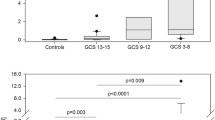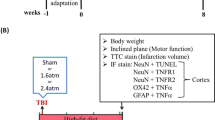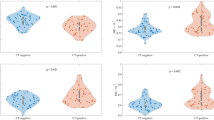Abstract
Background
It is well known that lipids are vital for axonal myelin repair. Diffuse axonal injury (DAI) is characterized by widespread axonal injury. The association between serum lipids and DAI is not well known. The purpose of this study was to investigate the associations of serum lipid profile variables (triglycerides, high- and low-density lipoproteins, and total cholesterol) with DAI detected by magnetic resonance imaging (MRI) and with clinical outcome for patients suffering from traumatic brain injury (TBI).
Methods
This study included 176 patients with a history of TBI who had undergone initial serum lipid measurements within 1 week and brain MRIs within 30 days. Based on MRI findings, patients were divided into negative and positive DAI groups.
Results
Of the 176 patients, 70 (39.8%) were assigned to DAI group and 106 (60.2%) patients to non-DAI group. Compared with the non-DAI group, patients with DAI had significantly lower levels of high-density lipoprotein cholesterol (HDL-C) in serum during the first week following TBI. Multivariate analysis identified HDL-C as an independent predictor of DAI. Patients with lower serum HDL-C levels were less likely to regain consciousness within 6 months in TBI patients with DAI lesions identified by MRI.
Conclusions
Plasma levels of HDL-C may be a viable addition to biomarker panels for predicting the presence and prognosis of DAI on subsequent MRI following TBI.


Similar content being viewed by others
References
Maas AI, Stocchetti N, Bullock R. Moderate and severe traumatic brain injury in adults. Lancet Neurol. 2008;7(8):728–41.
Jiang JY, Gao GY, Feng JF, Mao Q, Chen LG, Yang XF, et al. Traumatic brain injury in China. Lancet Neurol. 2019;18(3):286–95.
Tang C, Bao Y, Qi M, Zhou L, Liu F, Mao J, et al. Mild induced hypothermia for patients with severe traumatic brain injury after decompressive craniectomy. J Crit Care. 2017;39:267–70.
Abu Hamdeh S, Marklund N, Lewén A, Howells T, Raininko R, Wikström J, et al. Intracranial pressure elevations in diffuse axonal injury: association with nonhemorrhagic MR lesions in central. J Neurosurg. 2018;14:1–8.
Abu Hamdeh S, Marklund N, Lannsjö M, Howells T, Raininko R, Wikström J, et al. Extended anatomical grading in diffuse axonal injury using MRI—hemorrhagic lesions in the substantia nigra and mesencephalic tegmentum indicate poor long-term outcome. J Neurotrauma. 2017;34(2):341–52.
Ohno N, Ikenaka K. Axonal and neuronal degeneration in myelin diseases. Neurosci Res. 2019;139:48–57.
Balazs Z, Panzenboeck U, Hammer A, Sovic A, Quehenberger O, Malle E, et al. Uptake and transport of high-density lipoprotein (HDL) and HDL-associated alpha-tocopherol by an in vitro blood–brain barrier model. J Neurochem. 2004;89(4):939–50.
Roheim PS, Carey M, Forte T, Vega GL. Apolipoproteins in human cerebrospinal fluid. Proc Natl Acad Sci USA. 1979;76(9):4646–9.
Borghini I, Barja F, Pometta D, James RW. Characterization of subpopulations of lipoprotein particles isolated from human cerebrospinal fluid. Biochim Biophys Acta. 1995;1255(2):192–200.
Rosenson RS. Beyond low-density lipoprotein cholesterol. A perspective on low high-density lipoprotein disorders and Lp(a) lipoprotein excess. Arch Intern Med. 1996;156(12):1278–84.
Burger D, Dayer JM. High-density lipoprotein-associated apolipoprotein A-I: the missing link between infection and chronic inflammation? Autoimmun Rev. 2002;1(1–2):111–7.
Fellows K, Uher T, Browne RW, Weinstock-Guttman B, Horakova D, Posova H, et al. Protective associations of HDL with blood–brain barrier injury in multiple sclerosis patients. J Lipid Res. 2015;56(10):2010–8.
Yuan Q, Wu X, Cheng H, Yang C, Wang Y, Wang E, et al. Is intracranial pressure monitoring of patients with diffuse traumatic brain injury valuable? An observational multicenter study. Neurosurgery. 2016;78(3):361–9.
Licastro F, Hrelia S, Porcellini E, Malaguti M, Di Stefano C, Angeloni C, et al. Peripheral inflammatory markers and antioxidant response during the post-acute and chronic phase after severe traumatic brain injury. Front Neurol. 2016;7:189.
Yoo RE, Choi SH, Oh BM, Do Shin S, Lee EJ, Shin DJ, et al. Quantitative dynamic contrast-enhanced MR imaging shows widespread blood–brain barrier disruption in mild traumatic brain injury patients with post-concussion syndrome. Eur Radiol. 2019;29(3):1308–17.
Johnson VE, Weber MT, Xiao R, Cullen DK, Meaney DF, Stewart W, et al. Mechanical disruption of the blood–brain barrier following experimental concussion. Acta Neuropathol. 2018;135(5):711–26.
Hottman DA, Chernick D, Cheng S, Wang Z, Li L. HDL and cognition in neurodegenerative disorders. Neurobiol Dis. 2014;72:22–36.
Kelley BJ, Lifshitz J, Povlishock JT. Neuroinflammatory responses after experimental diffuse traumatic brain injury. J Neuropathol Exp Neurol. 2007;66(11):989–1001.
Ezaki Y, Tsutsumi K, Morikawa M, Nagata I. Role of diffusion-weighted magnetic resonance imaging in diffuse axonal injury. Acta Radiol. 2006;47(7):733–40.
Tong KA, Ashwal S, Holshouser BA, Nickerson JP, Wall CJ, Shutter LA, et al. Diffuse axonal injury in children: clinical correlation with hemorrhagic lesions. Ann Neurol. 2004;56(1):36–50.
Adams JH, Doyle D, Ford I, Gennarelli TA, Graham DI, McLellan DR. Diffuse axonal injury in head injury: definition, diagnosis and grading. Histopathology. 1989;15(1):49–59.
Giacino JT, Kalmar K, Whyte J. The JFK Coma Recovery Scale-Revised: measurement characteristics and diagnostic utility. Arch Phys Med Rehabil. 2004;85(12):2020–9.
Li L, Tan HP, Liu CY, Yu LT, Wei DN, Zhang ZC, et al. Polydatin prevents the induction of secondary brain injury after traumatic brain injury by protecting neuronal mitochondria. Neural Regen Res. 2019;14(9):1573–82.
Meaney DF, Morrison B, Dale Bass C. The mechanics of traumatic brain injury: a review of what we know and what we need to know for reducing its societal burden. J Biomech Eng. 2014;136(2):021008.
Holbourn AHS. The mechanics of brain injuries. Br Med Bull. 1945;3:147–9.
Gennarelli TA. Mechanisms of brain injury. J Emerg Med. 1993;11(Suppl1):5–11.
Strich SJ. Diffuse degeneration of cerebral white matter in severe dementia following head injury. J Neurol Neurosurg Psychiatry. 1956;19(3):163–85.
Tang-Schomer MD, Johnson VE, Baas PW, Stewart W, Smith DH. Partial interruption of axonal transport due to microtubule breakage accounts for the formation of periodic varicosities after traumatic axonal injury. Exp Neurol. 2012;233(1):364–72.
Haley RW, Dietschy JM. Is there a connection between the concentration of cholesterol circulating in plasma and the rate of neuritic plaque formation in Alzheimer disease? Arch Neurol. 2000;57(10):1410–2.
Björkhem I, Meaney S. Brain cholesterol: long secret life behind a barrier. Arterioscler Thromb Vasc Biol. 2004;24(5):806–15.
Chien JY, Jerng JS, Yu CJ, Yang PC. Low serum level of high-density lipoprotein cholesterol is a poor prognostic factor for severe sepsis. Crit Care Med. 2005;33(8):1688–93.
Skandsen T, Kvistad KA, Solheim O, Strand IH, Folvik M, Vik A. Prevalence and impact of diffuse axonal injury in patients with moderate and severe head injury: a cohort study of early magnetic resonance imaging findings and 1-year outcome. J Neurosurg. 2010;113(3):556–63.
Gennarelli T, Thibault L, Adams J, Graham D, Thompson C, Marcincin R. Diffuse axonal injury and traumatic coma in the primate. Ann Neurol. 1982;12(6):564–74.
Jang SH, Kwon HG. The ascending reticular activating system from pontine reticular formation to the hypothalamus in the human brain: a diffusion tensor imaging study. Neurosci Lett. 2015;590:58–61.
Niemeier JP, Perrin PB, Holcomb MG, Rolston CD, Artman LK, Lu J, et al. Gender differences in awareness and outcomes during acute traumatic brain injury recovery. J Womens Health (Larchmt). 2014;23(7):573–80.
Zhong YH, Wu HY, He RH, Zheng BE, Fan JZ. Sex differences in sex hormone profiles and prediction of consciousness recovery after severe traumatic brain injury. Front Endocrinol (Lausanne). 2019;10:261.
Ma J, Zhang K, Wang Z, Chen G. Progress of research on diffuse axonal injury after traumatic brain injury. Neural Plast. 2016;2016:9746313.
Mu J, Li M, Wang T, Li X, Bai M, Zhang G, et al. Myelin damage in diffuse axonal injury. Front Neurosci. 2019;13:217.
Wible E, Laskowitz DT. Statins in traumatic brain injury. Neurotherapeutics. 2010;7(1):62–73.
Klopfleisch S, Merkler D, Schmitz M, Klöppner S, Schedensack M, Jeserich G, et al. Negative impact of statins on oligodendrocytes and myelin formation in vitro and in vivo. J Neurosci. 2008;28(50):13609–14.
Funding
This study was supported by the National Natural Science Foundation of China (Grant No. 81802250) and the Presidential Foundation of Nanfang Hospital (Grant No. 2017C031).
Author information
Authors and Affiliations
Contributions
ZYH contributed to the study design, data collection, data analysis and interpretation, and critical writing of the manuscript. BZ contributed to data analysis and interpretation, and critical writing of the manuscript. RHH contributed to the data collection and critical appraisal of the manuscript. ZZ contributed to the data collection and critical appraisal of the manuscript. SQZ contributed to the data analysis and interpretation. YW contributed to the data collection and interpretation. JZF contributed to critical appraisal of the manuscript.
Corresponding author
Ethics declarations
Conflict of interest
The authors have no conflict of interest to declare.
Ethical Approval
Since all data were extracted from routine hospital records and fully anonymized before analysis, the need for formal review and consent was waived. This study was carried out in accordance with the recommendations of Nanfang Hospital, Southern Medical University. The protocol was approved by our Institutional Review Board.
Additional information
Publisher's Note
Springer Nature remains neutral with regard to jurisdictional claims in published maps and institutional affiliations.
Rights and permissions
About this article
Cite this article
Zhong, Y.H., Zheng, B.E., He, R.H. et al. Serum Levels of HDL Cholesterol are Associated with Diffuse Axonal Injury in Patients with Traumatic Brain Injury. Neurocrit Care 34, 465–472 (2021). https://doi.org/10.1007/s12028-020-01043-w
Published:
Issue Date:
DOI: https://doi.org/10.1007/s12028-020-01043-w




